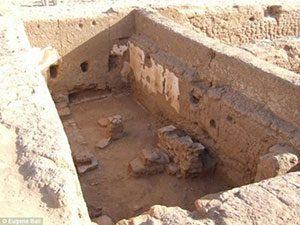
History of schools: Scribes writing (New Kingdom Egypt)
The history of schools
From the Stone Age to the end of the Middle Ages, most children never went to school at all. They stayed home until they were able to work, maybe five to ten years old, and then they worked, at home or in the fields, or in workshops, or in the mines. Only a few children could go to school.
Stone Age education
In the Stone Age, there were no schools at all. Whatever children learned, they learned from their parents and their friends, or from being apprenticed to a specialist like a flint-knapper or a weaver. Nobody knew how to read or write yet anyway.
Bronze Age: the first schools
By the Bronze Age, around 3000 BC, there were schools in Egypt and West Asia and (later, around 1500 BC) Greece for a few boys, who learned to read and write and do math (so they could keep accounts). These boys grew up to be scribes, who were a sort of combination secretary/ accountant/lawyer for kings and rich people. The schools were often in the king’s palace, or run by priests. The boys’ parents probably paid for their education. Schools like this probably operated in the Olmec kingdom in Mexico too, starting about the same time as in Greece.

A school room in Hellenistic Egypt with the walls decorated with verses from the Odyssey
But many traders, both men and women, also knew how to read and write, and so there were probably also schools for them. These schools probably involved a group of parents who hired a teacher and paid him to teach their children, maybe in an open square, maybe in a rented room, or maybe in one of their houses.
Nobody knows much about these schools, not even whether boys and girls went to the same schools. But still most children did not learn to read or write or count, and did not go to school at all.

Nalanda University, India
Iron Age – the alphabet
In the Iron Age, after about 1000 BC, the invention of the alphabet made it a lot easier to learn to read and write, and so professional scribes stopped being so important. More children learned to read and write, and to keep accounts. A teacher rented a room, or picked a place in a park or square, and set up a school, charging parents so much a month for their kids to go there. (That’s how music lessons or tae kwon do classes still work today). Of course you could only go if your parents could afford it, and if they wanted you to go. Most children, still, didn’t go to school, and didn’t learn to read or write.

A school in medieval China
The first universities
Around 500 BC, the Greeks developed a more organized system of education (or maybe it is just that we know more about it), where boys of different ages went to different teachers. Greek girls seem not to have gone to school much. Instead, their parents taught them at home, if they learned anything. (Though Sappho seems to have run a kind of school for girls). In the 400s BC, Buddhist monks in Mauryan India started advanced schools – universities – at Nalanda and Taxila and other places. Soon afterwards, Plato and Aristotle started advanced academies in Greece, too, and by the late 300s there was also a university in Alexandria, in Egypt.
By this time, schools were also getting going in China, where the government hired men based on how well they did on special tests, so if you wanted one of those jobs, you had to go to school.
School in the Roman Empire
The Romans greatly admired the Greek system of education, and didn’t change it much, though at least some Roman girls certainly went to school. Romans who wanted their children to get a good education sent them to Greece for college. At the same time, the Germans in northern Europe mainly did not have schools at all. Historians argue about how many of the Romans learned to read or write. Some historians think that most Romans could read and write. Other historians think very few could, and that people in the country mostly could not.

Clerks in the Manessa Codex (1300 AD). The teachers hold sticks to beat the kids.
Islamic schools
With the fall of Rome, in the Islamic Empire in West Asia, North Africa, and East Africa, after about 700 AD, a lot of mosques also opened schools. These schools taught reading and math, and also had their students memorize the Quran. Islamic universities opened in Baghdad and Cairo.
Monastery schools in Europe
Fewer people in Europe learned to read or write. Even a lot of Christian priests could not even read the Bible, though the bishops tried to make sure all the priests could read a little. Because of this, a lot of churches and monasteries began to run free schools for boys who were going to be monks or priests. Some girls who became nuns also learned to read and write.

Medieval university
Medieval universities
In the Middle Ages in Europe, most schools continued to be under the control of the Catholic Church or the Jewish synagogues. Gradually more advanced schools, called universities, began to grow up in some places. The most important ones were at Paris and Oxford and Bologna. All the teachers at these universities were monks or priests. This made it hard for girls to get an education, because only boys could become monks or priests. And still, most children never went to school.
Did you find out what you wanted to know about the history of schools? Let us know in the comments!



